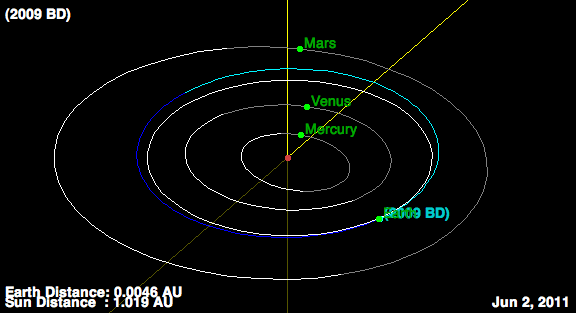
An asteroid the size of a small motorhome zoomed near Earth last night (June 1), coming closer to us than the moon ever does.
The 23-foot-long (7-meter) space rock, named 2009 BD, came within 215,000 miles (346,000 kilometers) of Earth at around 8:51 p.m. EDT (0051 GMT on June 2). The moon's average distance from us is about 239,000 miles (385,000 km).
2009 BD never threatened to hit Earth on this pass, researchers said. But even if the asteroid had slammed into us, it wouldn't have been a big deal.
"2009 BD is a small object, 7 meters, & poses no threat," scientists with NASA's Asteroid Watch program tweeted yesterday. "Rocky objects this size would break apart in our atmosphere & cause no damage." [Photos of Asteroids in Deep Space]
The asteroid's small size also made it a tough target for skywatchers. A large telescope was necessary to see it last night, researchers said.
Sticking around for a while
After the close pass, 2009 BD didn't recede into the depths of space like most asteroids do after such encounters. Rather, it continues to stick close to Earth, stalking our planet on its trip around the sun. In fact, the space rock will remain within 10 lunar distances of us for the next month or so, researchers said.
Breaking space news, the latest updates on rocket launches, skywatching events and more!
That's because 2009 BD is no ordinary asteroid. It's what astronomers call a "co-orbital object," meaning its path around the sun roughly parallels that of Earth. Just where such objects come from is an intriguing question, with some researchers speculating that they may be pieces ejected from the moon.
So 2009 BD will hang around for a while, periodically sidling up relatively close to Earth. The probability that it will ever actually hit us is extremely remote; the latest NASA calculations peg it at around 1 in 50,000.
While 2009 BD's orbit is somewhat unusual, its recent proximity to Earth isn't. NASA scientists have estimated that tiny asteroids probably pass between the Earth and moon on an almost daily basis. Most are just too small to be detected.
Space rocks as big as washing machines typically fall into Earth's atmosphere every month or so, but most of them burn up before reaching the ground, researchers say.
Learning about potentially hazardous asteroids
Of course, nobody on Earth wants to be caught unawares by an impending impact with a big, dangerous space rock. So NASA and other astronomers routinely scan the skies for asteroids or comets that may be an impact threat to Earth.
NASA is also taking more active measures to learn about potentially troublesome space rocks.
The agency recently announced, for example, that it's launching a sample-return mission called OSIRIS-Rex to the asteroid 1999 RQ36 in 2016. A probe will send pieces of the space rock home; they should reach Earth in 2023.
Scientists think these samples will contain pristine organic compounds, carbon-based molecules that are the building blocks of life as we know it. Studying these asteroid bits could shed light on the possibility that life on Earth was seeded by an asteroid strike, as some researchers believe.
However, 1999 RQ36 is also potentially dangerous, with about a 1-in-1,000 chance of striking Earth in 2182. That impact would likely not be trivial, since the asteroid is 1,900 feet wide (579 meters) — as big as six football fields.
Studying 1999 RQ36 and its movements up-close could help scientists refine their understanding of its orbit. This information could help them get a better handle on the space rock's trajectory, and possibly understand how to mitigate or prevent a potential Earth impact, researchers said.
You can follow SPACE.com senior writer Mike Wall on Twitter: @michaeldwall. Follow SPACE.com for the latest in space science and exploration news on Twitter @Spacedotcom and on Facebook.
Join our Space Forums to keep talking space on the latest missions, night sky and more! And if you have a news tip, correction or comment, let us know at: community@space.com.

Michael Wall is a Senior Space Writer with Space.com and joined the team in 2010. He primarily covers exoplanets, spaceflight and military space, but has been known to dabble in the space art beat. His book about the search for alien life, "Out There," was published on Nov. 13, 2018. Before becoming a science writer, Michael worked as a herpetologist and wildlife biologist. He has a Ph.D. in evolutionary biology from the University of Sydney, Australia, a bachelor's degree from the University of Arizona, and a graduate certificate in science writing from the University of California, Santa Cruz. To find out what his latest project is, you can follow Michael on Twitter.
